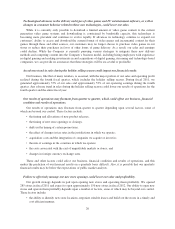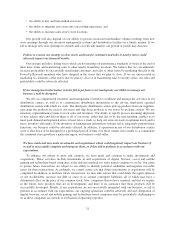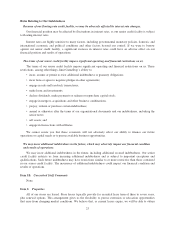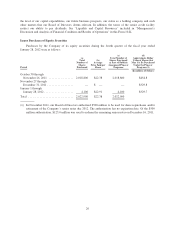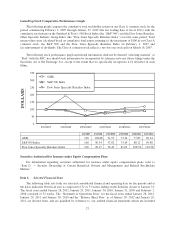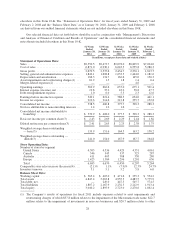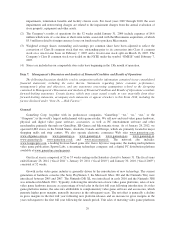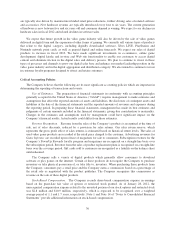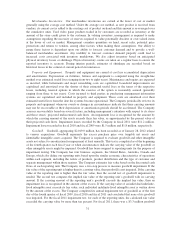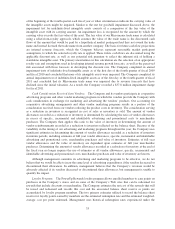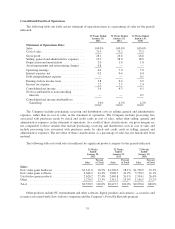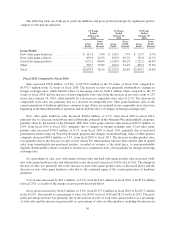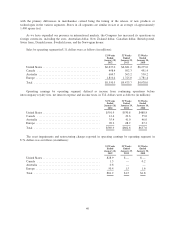GameStop 2011 Annual Report Download - page 46
Download and view the complete annual report
Please find page 46 of the 2011 GameStop annual report below. You can navigate through the pages in the report by either clicking on the pages listed below, or by using the keyword search tool below to find specific information within the annual report.are typically also driven by manufacturer-funded retail price reductions, further driving sales of related software
and accessories. New hardware systems are typically introduced every four to six years. The current generation
of hardware is now between five and six years old and consumer demand is waning. We expect to see declines in
hardware sales in fiscal 2012 and related declines in software sales.
We expect that future growth in the video game industry will also be driven by the sale of video games
delivered in digital form and the expansion of other forms of gaming. We currently sell various types of products
that relate to the digital category, including digitally downloaded software, Xbox LIVE, PlayStation and
Nintendo network point cards, as well as prepaid digital and online timecards. We expect our sales of digital
products to increase in fiscal 2012. We have made significant investments in e-commerce, online game
development, digital kiosks and in-store and Web site functionality to enable our customers to access digital
content and eliminate friction in the digital sales and delivery process. We plan to continue to invest in these
types of processes and channels to grow our digital sales base and enhance our market leadership position in the
video game industry and in the digital aggregation and distribution category. We also intend to continue to invest
in customer loyalty programs designed to attract and retain customers.
Critical Accounting Policies
The Company believes that the following are its most significant accounting policies which are important in
determining the reporting of transactions and events:
Use of Estimates. The preparation of financial statements in conformity with accounting principles
generally accepted in the United States of America (“GAAP”) requires management to make estimates and
assumptions that affect the reported amounts of assets and liabilities, the disclosure of contingent assets and
liabilities at the date of the financial statements and the reported amounts of revenues and expenses during
the reporting period. In preparing these financial statements, management has made its best estimates and
judgments of certain amounts included in the financial statements, giving due consideration to materiality.
Changes in the estimates and assumptions used by management could have significant impact on the
Company’s financial results. Actual results could differ from those estimates.
Revenue Recognition. Revenue from the sales of the Company’s products is recognized at the time of
sale, net of sales discounts, reduced by a provision for sales returns. Our sales return reserve, which
represents the gross profit effect of sales returns, is estimated based on historical return levels. The sales of
used video game products are recorded at the retail price charged to the customer. Advertising revenues for
Game Informer are recorded upon release of magazines for sale to consumers. Subscription revenues for the
Company’s PowerUp Rewards loyalty program and magazines are recognized on a straight-line basis over
the subscription period. Revenue from the sales of product replacement plans is recognized on a straight-line
basis over the coverage period. Gift cards sold to customers are recognized as a liability on the balance sheet
until redeemed.
The Company sells a variety of digital products which generally allow consumers to download
software or play games on the internet. Certain of these products do not require the Company to purchase
inventory or take physical possession of, or take title to, inventory. When purchasing these products from
the Company, consumers pay a retail price and the Company earns a commission based on a percentage of
the retail sale as negotiated with the product publisher. The Company recognizes this commission as
revenue on the sale of these digital products.
Stock-Based Compensation. The Company records share-based compensation expense in earnings
based on the grant-date fair value of options or restricted stock granted. As of January 28, 2012, the
unrecognized compensation expense related to the unvested portion of our stock options and restricted stock
was $2.8 million and $10.9 million, respectively, which is expected to be recognized over a weighted
average period of 1.1 and 1.7 years, respectively. Note 1 and Note 14 of “Notes to Consolidated Financial
Statements” provide additional information on stock-based compensation.
30


